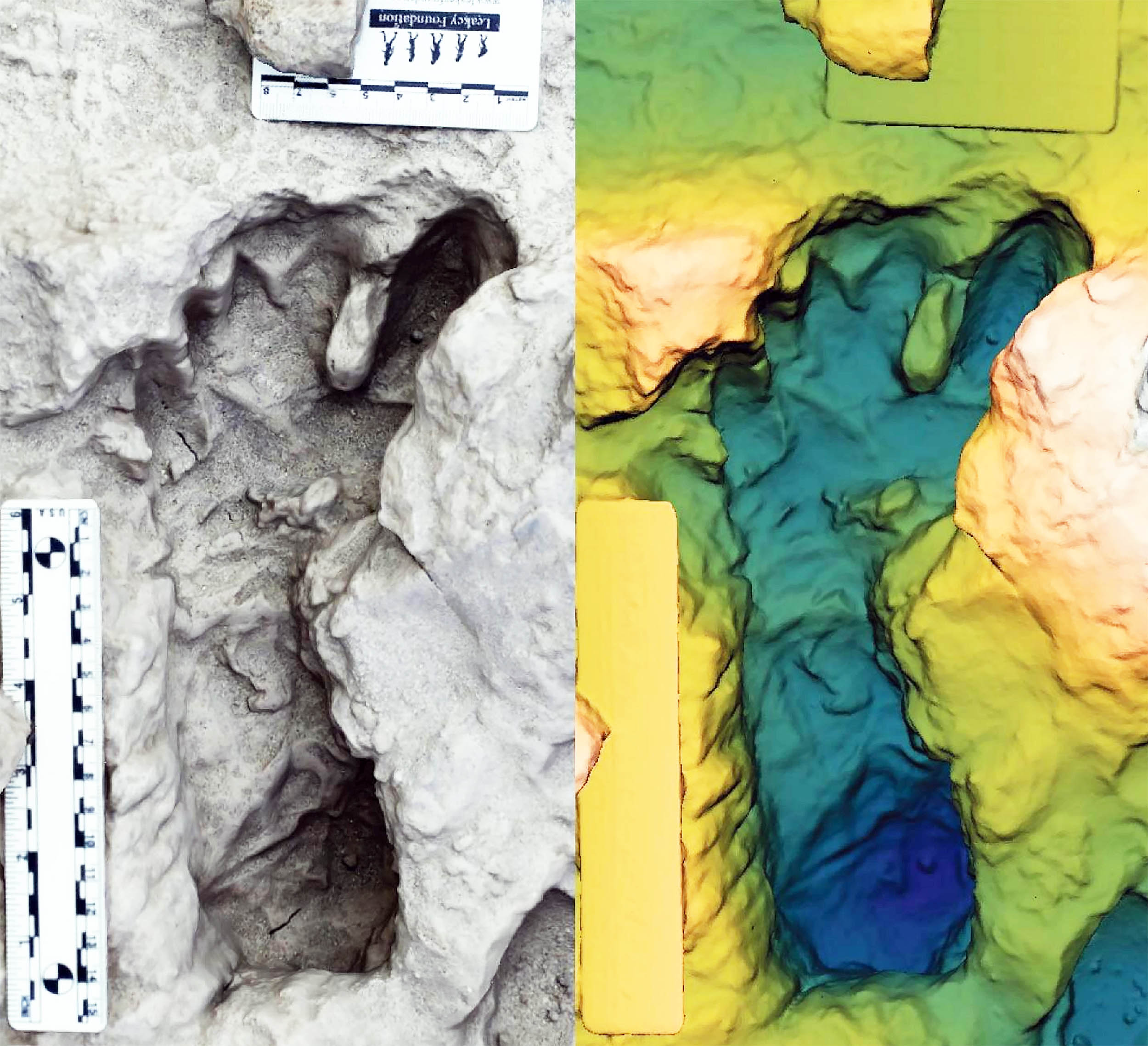Water pulls life together. Shorelines turn into busy corridors where birds, hoofed mammals, and different species of human ancestors, or hominins, crossed paths.
At Lake Turkana in northern Kenya about 1.5 million years ago, a short-lived window of wet silt captured that traffic with unusual clarity.
Scientists have studied those impressions and found a tight, almost real-time record of who walked there and how they moved.
Geology pins the scene to a narrow slice of time. A footprint layer lies a few meters below a volcanic ash bed dated to about 1.52 million years ago.
The prints formed and were buried quickly by fresh sediments, locking in delicate shapes before water or wind could erase them.
Thin, alternating beds of fine sands and silts mark a shallow shore that preserved what would normally vanish within hours.
One surface layer, labeled TS-2, records multiple hominin footprints alongside the prints of large wading birds, hoof marks from bovids, and impressions from horse-like animals.
Because the surface was walked on and then covered within hours or days, it shows neighbors sharing the same margin of the lake, not just species spread across centuries.
Researchers mapped a continuous hominin footprint trackway from one individual and three isolated hominin prints likely made by three others.
Around them, dozens of bird, bovid, and equid tracks fill the slab. Mud was firm at the top and softer a few inches down, which explains crisp toe marks and clear heels. Bedding above indicates gentle, rapid burial by fine sands.
“In biological anthropology, we’re always interested in finding new ways to extract behavior from the fossil record, and this is a great example,” explained Rebecca Ferrell, a program director at the National Science Foundation who helped fund this portion of the research.
“The team used cutting-edge 3D imaging technologies to create an entirely new way to look at footprints, which helps us understand human evolution and the roles of cooperation and competition in shaping our evolutionary journey.”
Footprints record kinematics – the mechanics of how a foot presses in, slides, and lifts out. Across early Pleistocene surfaces in the Koobi Fora area, the team found two recurring gait patterns side by side.
They show up on the same surfaces and repeat at nearby sites of similar age. That repetition points to more than one kind of hominin using the shoreline at the same time.
After comparing shapes, depths, and pressure patterns, the study interprets those paired signatures as two species already known from the region: Homo erectus and Paranthropus boisei.
“Their presence on the same surface, made closely together in time, places the two species at the lake margin, using the same habitat,” said Craig Feibel, an author of the study and a professor in the Department of Earth and Planetary Sciences and Department of Anthropology in the Rutgers School of Arts and Sciences.
Homo erectus likely walked with a more modern, distance-ready gait. Paranthropus boisei, with its robust chewing anatomy, may have moved differently – still upright, but not tuned for long, steady travel in the same way.
Importance of “trace fossils”
Feibel called the footprints significant because they fall into the category of “trace fossils” – a group that can include footprints, nests, and burrows.
Unlike body fossils such as bones and teeth, which record past life but can be shifted by water or predators, trace fossils capture behavior in place. Feibel added that trace fossils cannot be moved.
“This proves beyond any question that not only one, but two different hominins were walking on the same surface, literally within hours of each other,” Feibel noted.
“The idea that they lived contemporaneously may not be a surprise. But this is the first time demonstrating it. I think that’s really huge.”
Sharing space without blending roles
This evidence tightens “coexistence” from a loose idea into something you can see underfoot. Bones from the same rock members can show hominin species overlapping in a broad sense.
These trackways narrow the overlap to the same shoreline, within the same day or season.
That level of detail opens the door to ecological questions: how species met at water, how they avoided conflict, and whether they split resources through niche partitioning.
Lake margins concentrate food, shade, and safety. They also amplify competition. When many species converge, even small differences in gait, stamina, and foraging choices can tip the scales.
If Homo erectus covered ground more efficiently, it might have ranged farther between water and food. If Paranthropus boisei favored different foods or microhabitats, it could reduce head-to-head competition while still using the same shore.
“Fossil footprints are exciting because they provide vivid snapshots that bring our fossil relatives to life,” explained Kevin Hatala, the study’s first author, and an associate professor of biology at Chatham University in Pittsburgh, Pa., who has been investigating hominin footprints since 2012.
“With these kinds of data, we can see how living individuals, millions of years ago, were moving around their environments and potentially interacting with each other, or even with other animals. That’s something that we can’t really get from bones or stone tools.”
Confidence level and limitations
Footprints rarely identify species by size alone. Different hominins could leave similar-sized impressions.
What strengthens this case is the consistent pairing of two motion signatures across multiple sites, combined with the known fossil record for the area and time.
The prints do not show faces, but they reveal how bodies moved, and that can be just as informative for sorting out who shared the landscape.
The sediments and ash also reduce guesswork. Volcanic layers act like time-stamps. Once you date the ash, you can constrain the age of the tracks beneath.
Here, the ash near 1.52 million years provides that anchor, keeping the footprint surface close to 1.5 million years old.
This work highlights locomotion as a key thread in human history. Success did not hinge only on tools or diets.
It also rested on how efficiently ancestors traveled from water to food to shelter, and how they managed living near close cousins without constant conflict.
Movement shapes encounter rates, territory size, and access to resources. In a shore setting that bundles many needs into one place, the mechanics of each step matter.
A rare, clear, and exciting scene
On the most complete surface, one continuous hominin trackway and three isolated prints sit among many bird, bovid, and equid tracks.
The mud’s firmness near the top and softness just below produced sharp details, and quick burial preserved them for over a million years.
Most footprints vanish fast. These survived long enough to change what we can say about who stood where – and when.
Two branches of our family walked the same lakeshore at almost the same moment. Their steps carry different motion signatures, hinting at distinct strategies for getting around and getting by.
With geological precision and careful measurement, the study turns a broad idea – overlap in place and time – into a specific scene: early humans sharing a shoreline, leaving different styles of steps in the same soft ground.
The full study was published in the journal Science.
—–
Like what you read? Subscribe to our newsletter for engaging articles, exclusive content, and the latest updates.
Check us out on EarthSnap, a free app brought to you by Eric Ralls and Earth.com.
—–
First Appeared on
Source link













